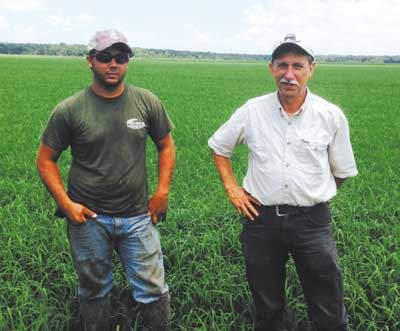|
Young Rice Farmer Overcomes Challenges Of The Land
JEANERETTE, LA.
It may be hard to believe, but 23-year-old Blake Viator from Jeanerette, La., has actually been farming for a decade.
“I started crawfishing in seventh grade,” he says. “There was a pond by my house someone had abandoned, so I started farming it. I started growing rice when I was 14, but I always planted it just as food for the crawfish. Last year, I harvested rice for the first time.”
Viator works as the crawfish and rice grower for Clint Feyou, who also farms primarily sugarcane and soybeans and raises cattle on almost 15,000 acres in Louisiana. This year, he farms 550 acres of both crawfish and rice, and an additional 200 acres of solely crawfish.
The land Viator farms is some of the most difficult land to farm in that part of the country, says David Ball, Dow AgroSciences sales representative. It is prone to flooding with heavily-textured soil that is difficult to work.

Photo of Blake Viator and his consultant, Danny Hebert
As a result, the fields would not support sugarcane, Viator says, but the landowners also didn’t want the fields to go unused.
“Our landlord asked us to do something with the land instead of letting it grow up,” he says.
Raising crawfish made sense. The land is low. Some of the fields are only a few feet above sea level. One field is two-feet below sea level – ideal conditions for crawfish and rice.
“There’s crawfish and rice out there for a reason,” Viator says.
Rice crop has quick turn
There is a small window for Viator to successfully grow rice once the crawfish is harvested. Since crawfish are harvested late into the year, Viator doesn’t plant rice until late June or early July. This leaves little room for error. Conventional rice is typically planted from March through June in Louisiana.
“When he plants rice, his window for success is narrow,” Ball says. “When you’re planting rice in the later part of June and the early part of July, you don’t have much time for forgiveness. You’ve got to get it right on the first chance.”
Last year was the first season in three years some of the fields were planted with rice due to relentlessly wet conditions. Viator says when they did finally plant those acres, they were fighting a high number of weeds. They managed to significantly reduce the weed pressure going into the current growing season.
“We’re starting a lot cleaner,” Viator says. “That’s really a big key to it. If you can start clean and you stay on top of it, you can end clean.”
Viator says he had success using RebelEX® herbicide for weed control last year, and he plans to use it again this year.
“It’s effective,” he says of RebelEX. “One of the ponds was really dirty and had a bunch of indigo and duke grass from the previous crawfish season, and it did a good job cleaning that up.”
Acreage increases, builds on success
Viator continues to build on a decade of successful farming, which grows each year. The operation purchased several new farms last year. This season, he almost tripled his rice acreage due to favorable weather conditions.
Thinking back to his first season of growing rice and crawfish, Viator says although it was successful, he sees it simply as another aspect of his dream job.
“For me, it’s like growing anything else – it’s just being a farmer,” he says. “Planting something and seeing it three months later when it’s fully mature and saying, ‘I did that. I grew that.’” ∆
|
|